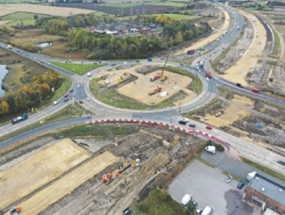CIRIA’s Sustainability Champions leading by example
Dirk Vennix, CEO, CIRIA shares his thoughts on the value of Sustainability Champions working within the construction and built environment sector.
In their book “Sustainable Infrastructure: principles into practice” Ainger and Fenner hit the nail on the head when they said:
“Your ability to help invent a sustainable future depends on two interacting things: your own individual capabilities and the characteristics of the organisation, project and sector in which you work, which comprises your ‘arena’ or context for change”.
Over the past decades, I do believe the construction sector has become increasingly aware of its responsibilities with regard to sustainability. CIRIA's vision of improving the industry's performance in this area through our many initiatives has helped paved the way to a net zero carbon and biodiversity net gain future. Our recent publications in support of this topic, include The Natural Flood Management Manual and Integration of non flood defence structures into the flood defence system. A review, with forthcoming titles including Repurposing and reconfiguring buildings, Sustainable management of waste soils and Environmental good practice on site, due out in the coming months.
However, there can be a big difference between understanding the potential for change and being able to deliver environmental benefits where it matters. Most construction companies now have sustainability functions and strategies, but still rely on a specific individual or team who will ‘go the extra mile’. Last year CIRIA members were invited to showcase some of these ‘sustainability champions’ who had developed transformational initiatives. With the support from BEIS, Construction Innovation Hub, Zero Waste Scotland and National Highways we published Sustainability Champions: case studies compilation (SP172F), which is free to download. This unique publication highlights new and practical approaches to early project life cycle decisions resulting in significant benefits relating to net zero carbon, materials resource efficiency or waste management. Ten interesting case studies illustrated the challenges, how the initiatives were implemented and, most importantly, the lessons learnt by the organisation and their stakeholders.
I wanted to share these learnings with a wider audience; CIRIA invited four Champions to share their achievements with the construction minister, Lee Rowley MP, and a broad cross section of our membership on a webinar in May. The minister stressed that sustainable, resilient, and high performing infrastructure is essential for UK’s long-term growth and prosperity. He mentioned the vital role played by CIRIA in sharing best practice on sustainability. A link to the ministerial address can be found here.
CIRIA’s webinar showcased real life examples of UK-based practitioners putting this vision into practice across devolved administrations and globally.
A moving story was told by Mott McDonald who shared a new case study whereby a whole region’s sustainability was central to the construction recovery project. In 2018, Central Sulawesi, Indonesia had been hit by a powerful earthquake killing more than 4,800 people and damaging the main canal responsible for irrigating more than 60,000 ha of land. Motts’ sustainable engineering assessment of the Gumbasa canal using BS EN 15978 revealed that the material content generated large quantities of embodied carbon. Replacing concrete with geogrid reinforced earthworks led to 65% reduction in embodied carbon.
National Highways, Costain and Jacobs showed how the transfer of surplus soils between a donor and receptor provided tangible sustainability benefits for an infrastructure improvement project on South Tyneside (A19/A184 Junction). They achieved a reduction in primary natural resources by reusing 73,350 m3 of soils, delivered carbon savings of 90,000 kg CO2 and saved £1M on aggregate costs.
Another example of low carbon and resilient management was presented by C-Probe. They controlled steel frame corrosion on the old Terry’s chocolate factory in York by using geopolymer anode mortar. These innovative materials yielded 80% less CO2 compared to traditional cement.
Zero Waste Scotland shared their learnings from creating and delivering the Resource Efficient Scotland programme in 2011. Business Energy Scotland runs the Green Champions training now (https://businessenergyscotland.org/summary-resources/). One of its trainees, Saltire Roofing & Building Ltd, adopted a timber first policy with local pickups and opted primarily for repair, reuse and second-hand purchases. As a result, over five years their fleet fuel consumption was reduced by 30% and landfill waste went down from 9% to 1.5%.
All presentations mentioned above can be found here.
I really hope CIRIA’s Sustainability Champions will inspire many more organisations to achieve change in the sustainability arena. My colleagues recently launched a virtual Environmental good practice in facilities management training course for practitioners and have started cross-industry collaboration on reuse of materials while commissioning and decommissioning new assets – with the Energy Institute - and eco-engineering for coastal asset management. Do join us in inventing a sustainable future for all.
 |
 |
| Testos Junction Roundabout |
Completed Testos Juction Flyover |